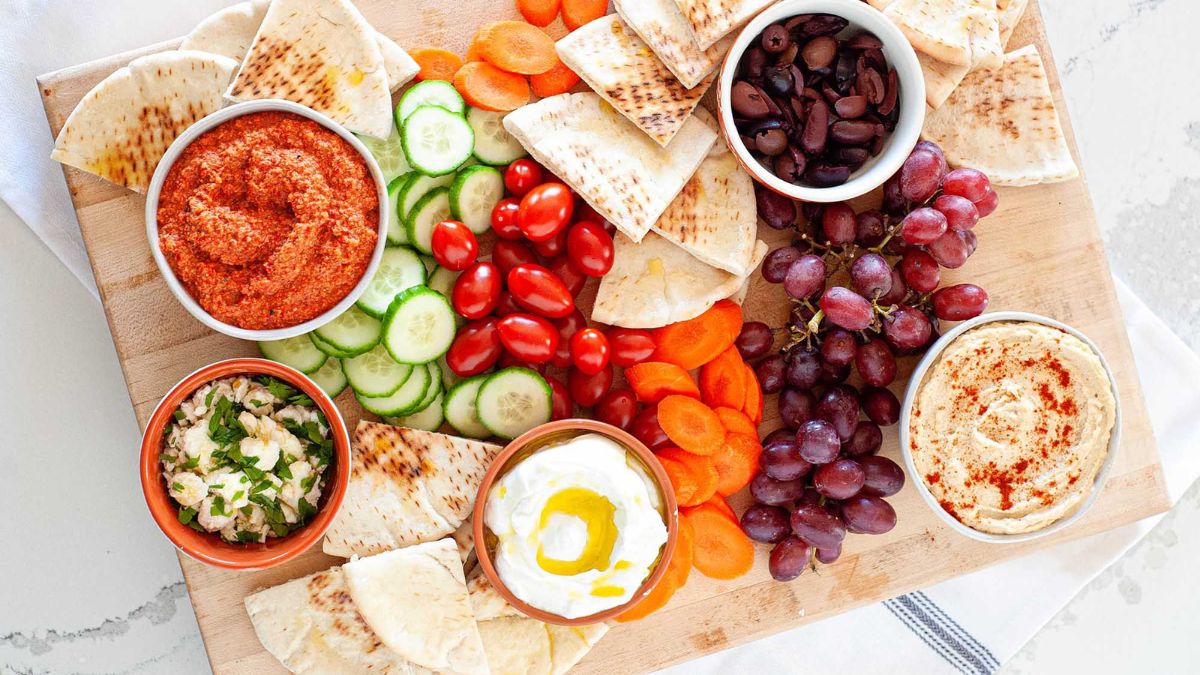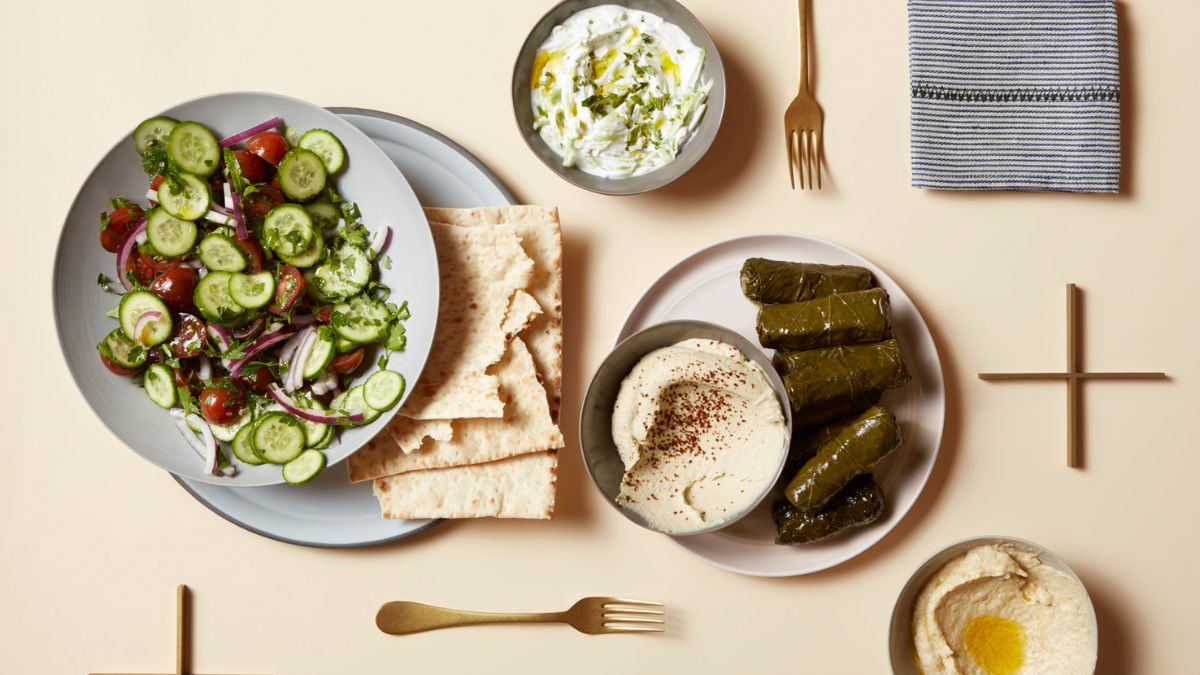Mezze is a traditional way to eat in the Mediterranean and the Middle East, and it’s mostly a bunch of tasty appetizers served with various drinks. Mezze has always been called “meh-zay.” Mezze is a mix of cold and hot foods, like vegetables, meat, dips, and bread, served with alcoholic and non-alcoholic drinks.
Mezze is eaten in many places worldwide, but no matter where it is, it always includes both hot and cold appetizers. A classic mezze also has olives, meat skewers or vegetable skewers, hummus, kebabs, tabbouleh, baba ghanoush, and dolma, along with different versions from different parts of the world. However, there’s no specific way of arranging or relishing a mezze platter, which varies from place to place.
What is a Mezze Platter?
Mezze, or Meze, is a collection of small dishes that can be eaten as an appetizer or light meal. Its contents change from place to place, but the idea of grazing on a board full of tasty things stays the same. People often use dips and spreads like hummus, yogurt, and baba ganoush. Muhammara, a spread made of red peppers and walnuts, might also be there, and it has a lot of flavor without being too spicy. Some bread, like pita or lavash, olives, cheeses, tabbouleh, fresh and pickled vegetables, and fruits are always included.
Mezze is a popular way of eating in the Mediterranean and the Middle East. It is similar to tapas, other small plates, and finger foods meant to make you hungry. But unlike those small dishes, Mezze (pronounced “meh-zay”) is meant to be a full meal. This way of eating includes cold and hot foods, like vegetables, meat, dips, and bread. It can be served with or without alcohol.
How to Make a Mezze Platter?
Making a mezze platter at home with food from the grocery store is easy. I try to get a mix of flavors and textures, like creamy, crunchy, fresh, pickled, dried, savory, and sweet. Depending on how many people you’re serving, my general rule is to have two to three dips or spreads, one cheese, a few fresh vegetables, one to two pickled things, fresh or dried fruit (or both), and bread. Here are the steps:
- Start with a few spreads, like hummus, baba ganoush, muhammara, and yogurt. You can make your own or buy some already made.
- Add a favorite cheese. Feta is easy to find and tastes good with a bit of olive oil and some fresh or dried herbs.
- Include flavorful olives or another pickled vegetable, like peppers or artichoke hearts.
- Cut up raw vegetables that are good for dippings, such as cucumbers, cherry tomatoes, carrots, fennel, and radishes.
- Include a suitable bread to scoop up all the goodies, like pita and lavash. These are delicious when lightly brushed with olive oil and heated in the oven or grill.
- Add dried fruits, such as dates, figs, apricots, or fresh fruits like grapes, melon, or pears.
- Set out a stack of napkins to manage messy hands.
Ingredients
- 1/2 cup Kalamata or other flavorful olives
- 1/2 cup plain Greek yogurt, stirred with a pinch of salt and drizzle of olive oil
- 1 cup hummus (homemade or store-bought)
- 1 cup Easy Muhammara
- 2/3 English cucumber, sliced
- 1 cup cherry tomatoes
- One large carrot, cut on the diagonal into slices
- Small bunch grapes
- 4 ounces feta cheese, broken into pieces, lightly drizzled with olive oil and a pinch of herbs
- Three pita bread, quartered, brushed lightly with olive oil, and warmed in the oven
Method
Make-Ahead Tips and Serving Suggestions
Mezze is a great meal to make ahead of time because you can put most of it together and put it in the fridge before you serve it. It can be served at a family dinner or to guests. This muhammara will keep well in the fridge for up to a week. Take everything out of the fridge at least 30 minutes before you’re ready to serve, so it’s closer to room temperature. To make last-minute changes, get your prettiest platter and pile everything on it. Small dishes or ramekins might be best for dips, spreads, olives, and feta. On your platter, you can put bread, vegetables, and fruits.
What is the Difference Between Mezze and Tapas?
People often compare Mezze to tapas, but even though both are small plates and finger foods, they are not eaten the same way. Tapas are small dishes from Spain that are meant to make you hungry, and they are often eaten as bar food before the main meal. On the other hand, Mezze is the meal and usually has even more things than the appetizers. Tapas are small dishes from Spain that are meant to make you hungry, and they are often eaten as bar food before the main meal. On the other hand, Mezze is the meal and usually has even more things than the appetizers.
Tapas are only found in Spain. They usually include roasted and salted nuts, olives, ham croquettes, patatas bravas (fried potatoes), grilled octopus, hard Spanish cheeses, slices of cured meat like chorizo, and pan con tomato, which is also known as tomato toast. Mezze has less fried food and more dips like hummus and baba ganoush, fresh pita or flatbread, kebabs, dolmas, herb-filled salads, olives, fresh cheeses, and cured fish and meat.
The main difference between tapas and Meze is that tapas are small Spanish dishes or snacks originally served with sherry. On the other hand, Meze is a small starter common in Turkish and Greek cuisine. They are similar to Spanish tapas, or Hawaiian pu pu, often served as a light meal with pitta bread.
What Dishes are in Mezze?
When a mezze spread is served, the dishes come out as they are ready. There is no set order, which usually means that dips and cold plates come out first, then hot foods and bread. Mezze can include just a few dishes or dozens, depending on what is available and how many people are eating. These are the main things you’ll find in a mezze spread, but each region has its specialties and spice blends.
Dips
When a mezze spread is served, the dishes come out as they are ready. There is no set order, which usually means that dips and cold plates come out first, then hot foods and bread. Mezze can include just a few dishes or dozens, depending on what is available and how many people are eating. These are the main things you’ll find in a mezze spread, but each region has its specialties and spice blends.
Kebabs
Kebabs came from the Middle East hundreds of years ago. They are skewers of cooked meat or vegetables. The meat, which can be lamb, goat, chicken, beef, or fish, tastes different depending on where it comes from. Most of the time, lamb is used to make oblong spiced meatballs in Armenia. Iraqi Mezze includes tikka, chunks of chicken or lamb that have been marinated and put on a stick. Pakistan and Turkey have the most kinds of kebabs, and kebab is almost always served with a mezze spread in those two countries. The kofta or kafta kebab is a popular type of kebab in Turkey. It is made of ground meat, onion, and spices and is shaped like a meatball on the skewer before it is cooked.
Salad
Most of the time, a mezze spread has at least one salad. Fattoush is a simple salad made with greens, tomatoes, and fried pieces of khubz, a type of pita bread. Beans, onions, sumac, and parsley make the Turkish dish piyaz. Tabbouleh is a popular dish in many different countries, and it is made with fresh parsley, lemon, bulgar, tomato, mint, onion, and spices. A Mediterranean za’atar salad is made with fresh za’atar, olives, and cut tomatoes.
Bread
Most bread served with Mezze is flat or round and made with yeast. Pita has been around for at least 14,500 years and is the most popular. Lavas is a thin, puffed bread that comes from Turkey, and it is often served hot. Lavash is another thin, leavened flatbread that is folded into large ovals and served in some places. On the savory side, bread-like burek or bourekas stuffed pastries are popular in Turkey, Israel, and other Middle Eastern countries.
Finger Foods
Dolmas, also called stuffed grape leaves, dolmades, time, and zebra, are a popular mezze dish made mostly of grape leaves stuffed with rice, onion, and parsley. This finger food comes from the Ottoman Empire and can be served hot or cold. Falafel can also be on a mezze platter, and it usually comes in small balls that are easy to pop in your mouth. Another popular item is halloumi, an unripened semi-hard cheese from Cyprus, and it is served grilled and cut into slices.
What to Drink with Mezze?
Usually, Mezze is served with local drinks, such as liquor and wine. Traditional drinks that go well with Mezze are usually flavored with anise. These include arak, tsipouro, ouzo, raki, and brandy made in Cyprus. Another popular drink with Mezze is white wine or a lighter red wine. Mezze can also be eaten with drinks that don’t contain alcohol, such as hot Moroccan mint tea, Turkish coffee, and karkade, a cold Egyptian drink made with hibiscus.
Origins Of Mezze
Mezze has been eaten for hundreds of years all over the Middle East and the Mediterranean, but it didn’t come from just one place. Instead, it grew out of the way for people in these areas to get to know each other over a meal without worrying about portions or how to plate each dish. The eater takes what they want and puts it on their plate, often returning for more. This also lets guests drop by without worrying about disturbing a formal dinner or leaving early without missing any food. Because these dishes are easy to make, they are often served at last-minute parties.
No matter where Mezze is eaten, it usually includes hot and cold foods. These might include a local version of hummus, tabbouleh (fresh parsley and mint salad), baba ghanoush (an eggplant dip), and dolma (stuffed grape leaves), as well as different olives and meat and vegetable kebabs. Each country has its specialties. For example, Turkey has Tulum cheese, Iran has kofte (herbed meatballs), and Greece has taramosalata (roe spread), a type of cured meat from Bulgaria. You can also find kibbeh, a cracked bulgur wheat croquette, and kafta, a meatball often served as a kebab.
Conclusion
Mezze is easy to eat; all you need is a plate and a hunger for it. Most of the time, silverware isn’t needed because these foods can be eaten with your hands, but serving tools are helpful for plating. Bread is used to pick up falafel and grilled meats and dips, and it can also be used to pick up falafel. Mezze is a popular food in the Middle East and has been an important part of the Mediterranean for a long time. The word “Mezze” is used in several cuisines from the former Ottoman Empire. It is thought to have come from the Turkish word “Mezze,” which means “snack” or “appetizer,” which is thought to have come from the Persian words “Mazzeh” or “Mazzah.”

